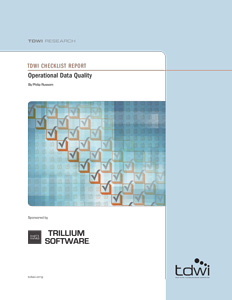
TDWI Checklist Report // Operational Data Quality
May 14, 2010
Failing to ensure high-quality operational data may put at risk many worthwhile business goals for operational excellence. For example, a Zero Defect or Six Sigma program in manufacturing needs clean, complete, consistent, and current operational data that quantifies supplies, suppliers, and products (both on the product floor and in the field). As another example, sales and marketing initiatives need cleansed, standardized, and enhanced operational data drawn from customer-facing operational applications and third-party providers if they want to increase conversion rates via better-targeted campaigns.
There are many other areas within the average enterprise where high-quality operational data contributes to operational excellence. In all these examples, people, processes, organizational structures, data, software, and other resources are already in place and operating. Most definitions of operational excellence prescribe incremental enhancements and optimizations for individual, pre-existing resources; the assumption is that localized improvements have a global impact on broad processes. In that spirit, this TDWI Checklist Report provides recommendations for improving the quality of operational data, which in turn contributes to an organization’s drive toward operational excellence.